MADRID, SPAIN — Weather conditions ranging from excessive heat to cooler-than-average temperatures and from drought to excessive moisture have curbed marketing year 2023-24 European Union (EU) winter grain production expectations, according to a Global Agricultural Information Network report from the Foreign Agricultural Service (FAS) of the US Department of Agriculture.
In a quarterly update, FAS Post Madrid revised its production outlook to 270.87 million tonnes of total grains – wheat, barley, corn, rye, sorghum, oats and mixed grains – down from 284.7 million tonnes projected in April. This remains, however, marginally higher than the 266.8 million tonnes estimated from 2022-23.
“The initially optimistic outlook for EU grain production was partially negated by uneven weather conditions,” the FAS said. “The production increase (year-over-year) is solely attributed to the improved yields expectations as all grains experienced area reductions.”
EU wheat production is expected to recover from last year’s levels and amount to 134.6 million tonnes in 2023-24. In most EU wheat-producing countries, weather was favorable to cultivation with the notable exception of Spain where extreme drought slashed yields.
The report raised concerns about the EU’s corn crop prospects due to July’s heatwave. Corn production is projected to reach 60 million tonnes, down from the Post’s previous estimate of 64.4 million tonnes, due to both lower-than-anticipated yield and area. It still would eclipse 2022-23’s estimate of 52.25 million tonnes but remain significantly lower than the 71.4 million tonnes produced in 2021-22.
EU barley production in 2023-24 has been revised down to 48.2 million as the severe drought, particularly in Spain, pushed yield expectations down. Yields are projected also lower than in the previous marketing year in Germany, the Netherlands, the Czech Republic, the Baltic States, and the Nordic Countries.
Food, seeds and industrial (FSI) grain uses in the EU have been revised up to 104.7 million tonnes in 2023-24, compared to previous estimates, as the new capacity for high-quality barley protein in Hungary becomes operational. EU’s feed grains consumption pace of decline is projected to slow down in 2023-24 and amount to 155.4 million tonnes.
The deterioration of the domestic crop, particularly Spain’s crop failure due to extreme drought, is expected to prevent EU grain exports from expanding and supports steady imports to the EU in 2023-24, which are pegged now at 31.6 million tonnes.
“The market had anticipated the discontinuation of the Black Sea Grain Initiative corridor for several weeks, facing delays in vessels’ inspections over the last few months,” the FAS said. “Traders managed their risk by stocking grains in destination markets and ensuring alternative sources, such as Brazil.”
Russia’s withdrawal from the initiative on July 17 has increased market volatility. If trade disruptions extend until autumn, alternative channels would need to be found to release the grain crop out of Ukraine. Intra-EU trade would then become particularly critical, and EU grain exporters could regain competitiveness in third-country markets.
The expanded influx of Ukrainian grains to the EU resulted in large volumes of ending stocks of wheat, corn and barley in 2022-23 in the five Ukraine-neighboring EU member states – Poland, Hungary, Slovakia, Romania, and Bulgaria. These countries are asking the EU Commission for an extension of the import restrictions of wheat, corn, sunflower seeds and rapeseed from Ukraine into their countries beyond Sept. 15, 2023.






